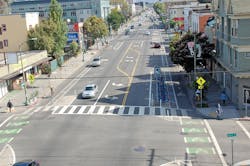Complete streets are streets for everyone.
That is the explanation offered by the National Complete Streets Coalition, a movement launched in 2004 that is part of the urban planning and development organization known as Smart Growth America. The coalition indicates on their website that the goal of a complete street is to enable safe access for pedestrians, bicyclists, motorists and transit riders—essentially all road users “of all ages and abilities.”
This is the exact goal that the Oakland Department of Transportation (OakDOT) in California had in mind when the agency made changes to the layout of Telegraph Avenue between 20th Street and 29th Street back in April 2016. The corridor is one of the city’s most important streets for transit, and the department saw a need to address pedestrian safety and to fix a gap in the bikeway network.
“It’s really that kind of multimodal corridor approach,” Sarah Fine, project planner at OakDOT for the Telegraph Avenue Complete Streets project, told Roads & Bridges. Fine explained that the department was looking specifically at reducing crashes for all modes of transportation. “One of the ways to do that is by reducing the number of travel lanes and making the traffic flow a bit more predictable.”
Cutting down
OakDOT did just that when they redesigned Telegraph Avenue to have one vehicle travel lane in each direction instead of two. According to OakDOT Director Ryan Russo, having four travel lanes on the corridor posed what he described as a “multiple threat challenge” for pedestrians in the crosswalks. “Our motorists do a good job, if they see a pedestrian, of yielding and allowing the pedestrian to cross the arterial, but when there’s two lanes, the first car that’s yielding can actually block the visibility of the pedestrian for the motorist in the second lane,” Russo told Roads & Bridges. He went on to explain that this issue increases the chances of those motorists hitting pedestrians in the crosswalk.
OakDOT confirmed that these types of safety concerns, for pedestrians and cyclists in particular, have been real issues on Telegraph Avenue in the past. “This corridor has been essentially one of Oakland’s highest injury corridors for probably all of time,” Fine said. “We looked at some historic crash data going back 60-70 years, and every year [the corridor] comes up.”
The city of Oakland began planning the complete streets project for 1 mile of Telegraph Avenue back in 2014. The solutions to increase safety for pedestrians and cyclists involved both implementing the road diet, which reduced the corridor to having one vehicle travel lane in each direction, and repurposing the remaining lanes to be parking-protected bike lanes stretching for 9 blocks down the street. In addition, eight high-visibility pedestrian crosswalks were added to the corridor. The crosswalks are designed as a ladder crosswalk, with two white lines stretching from one side of the street to the other, but also with a series of 2-ft markings in between to look like a ladder. This design is different from the typical continental crosswalk implemented throughout the rest of the city, which only consists of the two 12-in. white lines on each side of the crosswalk. All of these changes were implemented in early 2016.
The estimated cost to carry out the complete streets improvements on Telegraph Avenue was around $500,000, specific to the improvements made around bicycle and pedestrian safety. According to Fine, the project was delivered through a citywide resurfacing contract, with most of the funding coming from local sales tax dollars for transportation.
One mile of Telegraph Avenue in Oakland was reduced to one travel lane in each direction, and parking-protected bicycle lanes were added.
Complete success
The results of the complete streets improvements, once finished, proved to be exactly what OakDOT was hoping to bring to Telegraph Avenue. For one thing, the department noticed a change in the number of pedestrians and cyclists on the corridor. “At every single intersection we took before-and-after counts on, we saw greater increase in people walking and biking,” Fine said. The area where the complete streets work took place connects to the hub of Oakland. “The project connects to downtown Oakland’s uptown transit center, which is where practically all of your service bus network comes to rest and then carry off again,” Fine said.
In addition to the increased number of pedestrians and cyclists, OakDOT saw a decrease in the number of injuries. “For the first time in five years, no one has been hit at a crosswalk on Telegraph,” Fine said. “I think that is one of the biggest stories to come out of this project.” According to recent surveys conducted by the department, 79% of bicyclists and 63% of pedestrians said they feel safer on Telegraph as a result of the complete streets implementation.
Another notably positive difference the complete streets work on Telegraph has made is that the reduced travel lanes have helped to curb speeding by motorists on the corridor. While the speed limit has not changed, OakDOT has seen a 45% decrease in southbound speeding and a 27% decrease in northbound speeding on Telegraph in the area of the project. More drivers are driving closer to the speed limit, and the median speeds on the corridor are the same as the speed limit, putting to rest any fears that residents may have had that traffic would slow to a crawl. Capacity levels on the corridor did not suffer too badly either. Telegraph carries about 14,000 vehicles per day on it, and with the complete streets improvements, OakDOT only saw a 3% decrease in vehicle trip.
Fine also noted that the yield rate to pedestrians in crosswalks from motorists driving down Telegraph has gone up. Before the complete streets project, the yield rate was at about 20% with four travel lanes. With the road diet cutting Telegraph down to two lanes, the yield rate has increased to 67%.
OakDOT also compared the area of the project to the speeding trends that were found 10 blocks up on Telegraph Avenue. In the complete streets area, the number of motorists traveling above the speed limit in one direction prior to project completion was 64%. After the project was finished, that number dropped to 35%. However, 10 blocks away from the project area told a different story. Before complete streets work was implemented, 83% of motorists in that area of the corridor would drive over the speed limit, and that number has actually increased to 84% since completion. This led OakDOT to believe the complete streets work really made a difference in combating speeding in the project area along the corridor.
What’s next?
While OakDOT has seen significant progress on Telegraph Avenue as a result of their complete streets work, there were some areas where improvements needed to be addressed after project completion.
While the parking-protected bike lanes provided a safer and clearer route for cyclists, some parking spaces along the corridor needed to be eliminated due to the bike-lane configuration. To accommodate businesses who relied on those parking spaces, OakDOT was able to identify locations on adjacent streets where more parking opportunities could be opened up, instituting additional short-term usage along the side streets to support merchants along Telegraph. The department also will be adding permanent signs for Telegraph visitors to help explain where to park.
One element of the complete streets design that became a cause for confusion were the beige zones next to the bike lanes that were meant to be kept clear and provide sight lines for bicyclists and pedestrians crossing at intersections. Some residents, however, were initially confused about these painted safety zones, thinking they may have been parking or loading spaces. To make things clearer, OakDOT added additional flexible delineators to visibly show drivers that those areas were not meant for parking. The department also will be adding vertical separators at the beginning of bike lanes in certain areas.
Recognizing that Telegraph also functions as an important transit corridor, OakDOT will be adding bus boarding islands to the project area over the next few years. These islands will create a separation between buses and bicyclists at bus stops to make passenger boarding run smoothly.
The Telegraph Avenue complete streets project has become a model for the potential of transportation safety in the city of Oakland, where voters recently passed an infrastructure bond to fund OakDOT. “We think this project here on Telegraph Avenue is emblematic of the approach and what we want to deliver with our streets in the city of Oakland,” Russo said. “On the qualitative level, I would say it’s a real accomplishment in spurring the conversation in the city about what we can get out of our streets, and who and how they can serve.”

